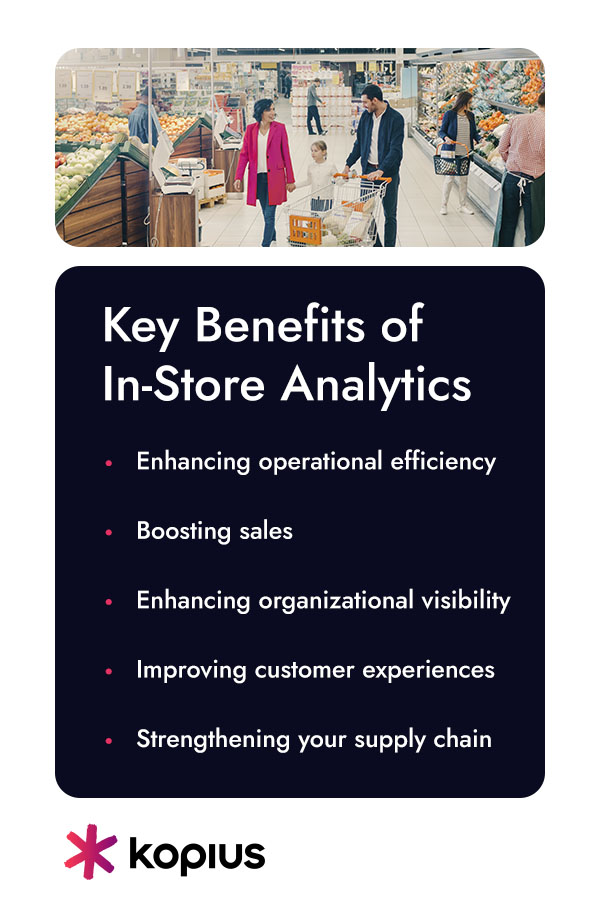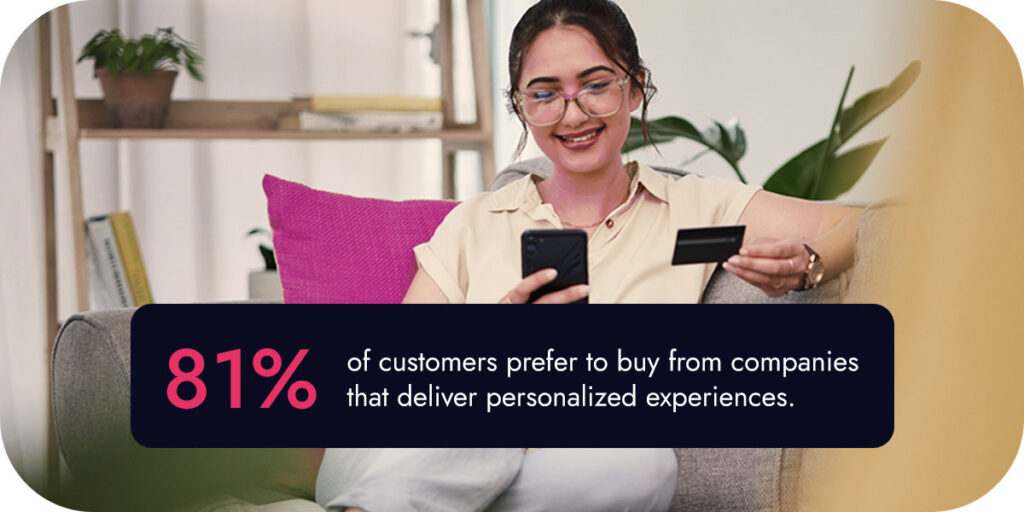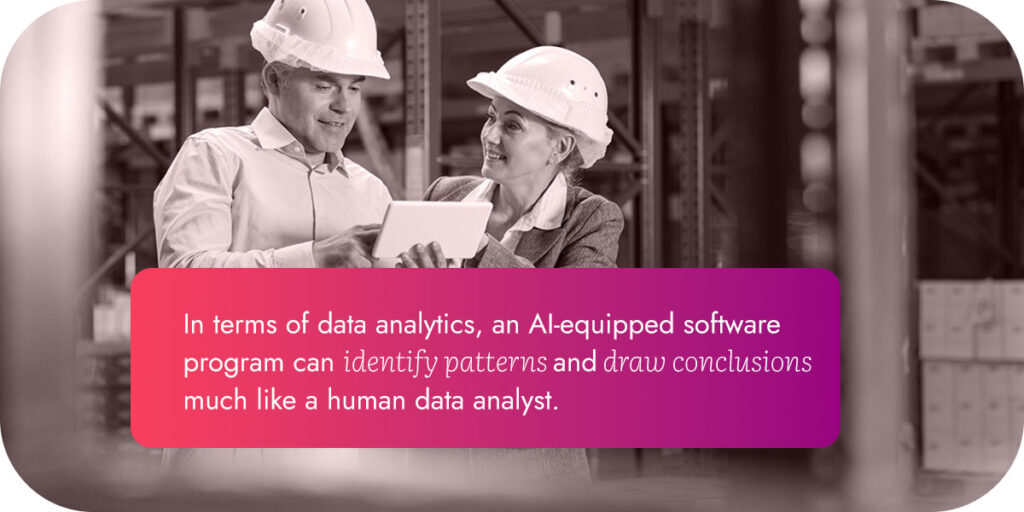
Although in-person shopping has recovered well from the pandemic, many customers feel frustrated with the experience of visiting brick-and-mortar stores.
Unified retail analytics solutions, which combine in-store technology with integrated software and advanced algorithms, can help your store learn more about your customers’ common pain points and desires so you can better cater to them.
When your customers are freer than ever to abandon your business for a competitor, you need a solution that can help you make your store the best place to shop. Using data analytics for retail operations is the key to gaining an edge in this hyper-competitive sector.
What Is Retail Analytics?
Retail analytics is the science of collecting and analyzing business data to improve your business outcomes on an ongoing basis. Depending on which sales and marketing channels your company uses, your data sources might include:
- In-store devices and sensors.
- Online storefronts.
- Catalog orders.
- Social media platforms.
Once you’ve collected all the data you need, you’ll run analytics to create reports that reveal valuable insights into your store’s business. Several types of retail business analytics exist with varying levels of complexity:
- Descriptive: Descriptive analytics provides the most basic level of data insights for your business, such as which locations carry certain products, how much of each item is on the floor, and how often store employees restock shelves. This data informs more sophisticated analytics programs.
- Diagnostic: Running diagnostic analytics on your descriptive data helps you identify and understand the issues you’re facing in real time so you can find actionable solutions.
- Predictive: Predictive analytics algorithms use AI to analyze your historical data and predict likely future events based on different variables, including evolving economic circumstances and supply chain disruptions.
- Prescriptive: Similar to predictive analytics, prescriptive analytics uses AI algorithms to recommend solutions to the forecasts from the predictive analytics system.
The Role of Data Analytics in Retail
Historically, the retail industry has relied on intuition to make decisions about inventory, store layout, customer communications, and more.
Even the slightest adjustment can cause major consequences for inventory movement and profitability. For example, choosing to offer a 15% discount on a product over a 10% discount can cost you thousands in lost revenue — especially if you apply it to the wrong product.
Retail tech solutions eliminate the guesswork by using data and advanced digital technologies to enable more informed decision-making. Data-driven decisions can help you commit to continuous improvement and sustainable business growth.
That’s what we do at Kopius. Our team takes a collaborative approach to every project, working closely with your company’s best and brightest to design custom retail analytics solutions.
With the most accurate data at your fingertips, you can empower your team to streamline retail store operations, whether you’re focusing on an online storefront or a brick-and-mortar shop.
Key Benefits of In-Store Analytics
A well-designed retail store analytics solution helps boost business for retail companies of all sizes. Whether you’re a small local business or a multinational corporation, retail analytics can help you gain a competitive edge in the market by:

- Enhancing operational efficiency: Retail store analytics makes a proactive approach to inventory management and customer service possible by alerting you to potential issues and recommending appropriate solutions before anything happens.
- Boosting sales: Trends in the data you collect on customer preferences and in-store shopping behaviors help you identify ways to improve marketing, store layout, upselling, and cross-selling to bring in more sales.
- Enhancing organizational visibility: Retail location analytics enables you to generate insights from all your physical stores and warehouses in real time, so you always have the most up-to-date information at your fingertips for data-backed decisions.
- Improving customer experiences: When you start paying attention to customer preferences, it becomes easier to anticipate their needs and expectations. This enables you to deliver convenient, engaging shopping experiences that delight consumers.
- Strengthening your supply chain: Retail analytics solutions are cloud-based, which enables them to scale as needed. This flexibility means you can monitor your entire supply chain for even more accurate decisions.
Remember that these solutions work best when they’re purpose-built for your company. A solution that claims to be “one-size-fits-all” usually leaves some gaps in data collection and analysis, which can cause you to miss important insights.
Emerging Applications for Data Analytics in the Retail Industry
Retail store analytics solutions have enormous potential for enhancing performance across all types of stores, including in-person and online. Here are some of the most promising ways businesses have leveraged retail analytics solutions to get ahead in the industry.
Enhancing Omnichannel and Multichannel Retail and Shopping Experiences
Omnichannel and multichannel strategies rely on accurate, up-to-date data to generate the results you’re looking for.
Although many sources treat omnichannel and multichannel experiences the same, they’re actually different strategies:
- Multichannel: A multichannel strategy uses multiple channels, including websites, social media platforms, brick-and-mortar stores, and mobile apps, to facilitate customer interactions. Because each channel acts as a separate entity with its own goals, the customer experience can vary. This can help you appeal to a different segment of your customer base through each channel.
- Omnichannel: An omnichannel strategy integrates all your sales and marketing channels to provide a seamless, consistent experience in every interaction. This approach allows you to combine the strengths of each channel for greater customer satisfaction.
For both types of experiences to work, you need a reliable source of customer data, which is where your in-store retail analytics technology comes in.
Integrated IoT sensors collect data on stock movement and customer shopping behaviors, and AI-powered analytics assess that data to identify trends that could help you improve your experiences.
For example, a customer might use your mobile app to put an item they like in their shopping cart, but they abandon their cart before checking out. If they visit your store, your analytics solution could serve them an ad featuring the product.
Leveraging Customer Behavior Insights for Business Growth
Understanding typical customer behaviors can reveal the rationale behind their purchasing decisions, which is important for effective marketing and sales.
Retail analytics solutions can help you uncover valuable insights into how your customers think, which can help you grow your business by:
- Maximizing customer lifetime value: The more a customer purchases from your company, the higher their lifetime value and the more revenue you gain. Detailed customer insights can help you understand where to apply your focus to keep your most valuable customers satisfied.
- Minimizing customer churn: Analyzing trends in customer behavior can predict when customers are most likely to abandon your brand, which reveals opportunities to improve the customer experience.
- Improving your marketing results: Effective omnichannel and multichannel marketing strategies rely on customer data to keep audiences engaged with your brand. Collecting customer behavior data in physical stores and online channels provides a more comprehensive understanding of your customers that can boost results.
- Identifying opportunities for expansion: If you’re considering expanding into other regions, accurate customer data can help you gauge which markets your business will most benefit from.
Personalization: The Key to Immersive Shopping Experiences
Personalized customer experiences are no longer just “nice to have” — they’re now a necessity for keeping your customers engaged in your business.

One study found that 81% of customers prefer to buy from companies that deliver personalized experiences. That goes for both e-commerce platforms and in-person shops.
Catering directly to your customers is essential for delivering more immersive shopping experiences both in-store and online by:
- Delivering relevant discounts and offers to individual customers’ phones based on their history with the brand.
- Identifying previous interactions to identify and guide customers to the specific items they’re looking for.
- Sending customized marketing messages via the customer’s preferred communication channels.
- Recommending relevant products and deals to specific customers for upselling and cross-selling.
- Using virtual reality (VR) and augmented reality (AR) technologies to allow customers to preview products in upcoming releases.
With all the choices customers now have for both in-person and online shopping experiences, it’s important that your store meets customer expectations and differentiates itself from all the other retail businesses in your sector.
Inventory Management and Sales Forecasting
Accurate sales forecasting is critical for ensuring you have the right amount of stock on hand. Too much and you end up with dead stock and lost revenue. Too little and you run into stockouts and frustrated customers.
A comprehensive retail analytics solution that integrates with an inventory management platform improves sales forecasting through predictive analytics. The platform can analyze historical trends to generate insights into what to expect over the next period, such as:
- Identifying characteristics of products that sell well.
- Predicting when you should expect higher demand than usual.
- Making stocking recommendations for specific products.
- Determining which sales channels to divert more inventory to.
You can even use this technology to ensure proper stocking on your sales floor. For example, you can predict which products will sell faster, which can help you determine exactly how many units to put on the shelves and the best intervals to restock.
Digital Technologies Driving Retail Analytics
In-store retail analytics solutions are complex, with both online and offline components:

- The Internet of Things (IoT): The IoT is a network of internet-connected objects, such as sensors and mobile devices, that communicate wirelessly with each other and the cloud. This technology allows streamlined data collection and communication, which is essential for a unified retail analytics system.
- Artificial intelligence (AI): AI is a branch of computer science that allows machines to “think” like humans. In terms of data analytics, an AI-equipped software program can identify patterns and draw conclusions much like a human data analyst.
- Machine learning (ML): ML is an AI technique that analyzes previous outcomes and “learns” from them, incorporating feedback on an iterative basis. Essentially, ML enables your AI-powered software to continuously improve the predictions it makes so you can easily meet rising customer expectations.
- Business intelligence (BI) solutions: BI platforms leverage AI and ML capabilities to analyze business data and generate actionable insights for effective, data-driven decision-making.
- Point-of-sale (POS) systems: Your POS system is the point at which your business makes sales. This system can be a physical device you use to check customers out in-store or virtually, such as a payment form in your e-commerce channels.
- Inventory management platforms: These systems allow your warehousing and logistics teams to track products as they move through the supply chain, which helps you fulfill online orders more efficiently while keeping your brick-and-mortar locations stocked appropriately.
- Customer relationship management (CRM) systems: A CRM platform consolidates all your customer data into one centralized hub, making it easier for customer service reps and marketing teams to deliver personalized experiences and build brand loyalty.
Deep integrations between each piece of your retail analytics solution create a seamless data flow across every channel and tool in your system. This process ensures easy access and analysis. That’s why it’s so important to design a comprehensive system where each component is compatible — as long as they can work together, your solution should provide smooth, streamlined results.
The Future of Retail Analytics and Store Operations
Analytics has become essential for more efficient in-store operations in retail businesses across all sectors, and its importance will continue growing well into the future.
The evolution of retail analytics will follow advances in the technologies behind it, especially in AI, ML, and IoT. AI and ML have only become mainstream in the past couple of years, and IoT is still developing in many ways.
As more businesses begin implementing automated processes, these digital technologies will become more necessary in their day-to-day operations. Getting ahead of the curve and investing now can help your company become more competitive in the long run.
Getting Started With Retail Tech for In-Store Operations
Diving in headfirst without taking the time to plan your transformation is one of the biggest mistakes in starting out with retail tech.
Instead, it’s best to take a phased approach that accelerates results while empowering your front-line employees to focus on customer services. Start by identifying your most important goals and focus on achieving these first.
Consulting with a team of retail tech experts is one of the best ways to begin outlining your implementation strategy. The team at Kopius is uniquely qualified to help.
How Kopius Can Help
A team of experienced retail tech consultants can help you identify the right solutions for your business, designing a custom in-store retail analytics solution tailored to your unique requirements. That’s where the JumpStart program from Kopius, Inc. comes in.
The JumpStart program is our data-driven approach to the common pain points retail companies face daily. Our people meet with yours to discuss your needs and expectations, and we work closely with you to determine the right configuration of digital technologies for your goals.
Read our case studies to see how we’ve helped businesses like yours implement robust retail tech solutions and achieve excellent returns.

JumpStart Your Retail Operations With Help From Kopius
If your company is considering investing in retail analytics solutions, you can count on Kopius to help you create a comprehensive system that meets your store’s unique needs.
We designed our JumpStart program to spark innovation and drive customer, digital technology, and data success. By combining tech smarts and collaboration with a user-centric approach, we can help you fast-track business results and platform solutions.
Add our brainpower to your team and see where we can take you. Contact our specialists today to JumpStart your future success.
Related Services: